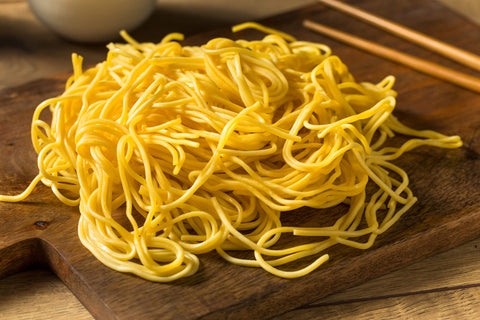
Japanese cooking can often seem quite simplistic and minimalistic, with many dishes comprising of rice or noodles, served with vegetables and a source of protein. Of course, as anyone who has experienced a Japanese cuisine will be able to tell you, this woefully underplays the country’s style of cooking. While there are certain core ingredients, the complexity of flavours that are possible in many Japanese dishes needs to be experienced in order to be fully appreciated.
Popular Japanese Sauces
While there are numerous types of dipping sauces, marinades, braising liquids, and more, in this article we are concentrating on some of the more popular varieties – ones you can expect to find readily-available in a Japanese restaurant or supermarket.
Mentsuyu
Mentsuyu (also known simply as tsuyu, meaning noodles) combines mirin, sake, kombu, soy sauce, and bonito flakes (katsuobushi) to create a strongly-flavoured and smoky broth that can be used as the basis for a soup or hot pot, or as a dipping sauce for soba noodles and tempura.
Mitarashi
Mitarashi is a popular glaze for confections and sweet rice dumplings. It is made primarily from soy sauce and sugar that is often kokuto from Okinawan black sugar case, combined with water and a thickening agent to add viscosity.
Okonomiyaki sauce
This sauce combines the sweet with the savoury, having a powerful undertone of umami. Made from oyster sauce, ketchup, Worcestershire sauce, and sugar, it is used to accompany a dish of okonomiyaki (griddled savoury pancakes that originate from both Osaka and Hiroshima in local forms).
Ponzu
Ponzu is a popular dipping sauce, having both a thin consistency and a powerful, tangy flavour. It starts out as a combination of bright, tangy ponzu sauce and is made by simmering mirin and rice vinegar with bonito flakes and kombu. The resultant liquid is then strained and blended with strong, citrus juices. This is usually yuzu, but any citrus can be used sushi as Sudachi, Kabosu, Dai Dai and more.
Soy sauce
As you’ll see from this page, soy sauce is the godfather of sauces in Japanese cuisine, forming the basis of many of the other sauces on this list. Even within its own category, there are many varieties of soy sauce to choose from. Known for its salty and umami flavours, soy sauce is regularly used as a dipping sauce, without any additional ingredients.
Tare
Tare (pronounced Tar-ray) directly translates to "sauce" in Japanese, is the name given to a multi-purposes sauce that is used as both a glaze and dipping sauce. Similar to the more famous teriyaki, tare is made from sweet mirin, soy sauce, brown sugar, and sake. It has an earthy sweetness that pairs well with most meats.
Takoyaki sauce
Takoyaki are grilled octopus balls that are popular in Japanese izakaya (a sort of informal bar or gastropub). They are often served with the sauce that bears their name, either served on the side for dipping, or drizzled over the top. Takoyai sauce is made up mentsuyu, Worcestershire sauce, ketchup, and sugar and has a unique flavour combining sweetness, saltiness, and a slight acidity.
Teriyaki
Perhaps the most famous Japanese sauce (not counting soy sauce) teriyaki has a sweet and salty flavour. Surprisingly, it was not originally invented in Japan. Emigrants to Hawaii mixed soy sauce and brown sugar with the juice of local fruits like pineapple to create this iconic marinade. The classic ingredients for teriyaki include soy sauce, mirin, cooking sake, brown sugar, garlic, and ginger.
Tonkatsu sauce
Tonkatsu sauce is often served with fried and breaded dishes such as tonkatsu itself (pork cutlet), menchi and chicken katsu, korokke (potato croquettes), and stir-fried noodles (yakisoba). It can be served as a condiment or a dipping sauce and has a complex range of flavours that combine the sweet with the savoury.
Unagi sauce
Like takoyaki sauce, unagi sauce takes its name from the dish it is most often paired with – unagi, or eel. However, this rich, soy sauce-based condiment has incredible flavours that work well with a range of meats and vegetables. Best described as a combination of sweet, salty, smoky, and umami tastes, it is a popular addition to grilled and barbecued meat and fish, as well tofu, mushrooms, and onigiri.
Yakiniku
Yakiniku is a sub-variety of tare sauces and is usually adopted as a dipping sauce in dishes like teppanyaki. While there are many ways to recreate yakiniku, the core ingredients are garlic, soy sauce, vinegar, miso, sake, and mirin. To this, various fruits can be added to produce an even sweeter sauce.
Yakitori Sauce
Yakitori Sauce is a popular sauce, similar in both flavour and usage to teriyaki sauce. It is made up of soy sauce, mirin, sake, and water, with brown sugar to help it stick to the meat. Some brands include additional flavours such as garlic and ginger. This versatile sauce can be used as a marinade for chicken, port, or beef; a glaze for vegetables and fish; or a dipping sauce. It is sweet and savoury, delivering a range of umami flavour notes. In yakitori restaurants, the yakitori sauce pot that the chicken skewers are dipped in is topped up daily but never fully cleaned. Meaning the chicken stock from years and years of dipping develops into a deep meaty taste.
Ketchup
Ketchup is extremely popular in Japan, where it is served with a wide variety of dishes. These include hayashi rice, Japanese curry, ketchup fried rice, Napolitan (ketchup spaghetti). It is particularly popular as an accompaniment to Japanese omelettes or omurice.
Making Japanese Sauces
Making any of the sauces listed above is a simple process, usually little more than mixing the core ingredients together and heating or reducing. While professional recipes can point you in the right direction in terms of the ratio between ingredients, most Japanese cooks would expect to improvise with their measurements, creating their own unique flavour notes.

Buying Japanese Sauces
While all the sauces on this page are simple to make at home or in a professional kitchen, they are even easier to buy ready-made. Off-the-shelf Japanese sauces can be just as delicious as a home-made version. Different producers create their own take on the sauces, so there is plenty of variety in terms of taste. Finding the right one for you can be an adventure in itself.
Popular Products
These are just some of the Japanese sauces that prove particularly popular at SushiSushi. Click on a link to learn more, or visit our online store for more Japanese sauces.
Bull-Dog Tonkatsu Sauce
Bull-Dog sauce is an example of yoshoku – Western food transformed to meet the Japanese palette. Made from a blend of vegetables, spices, and fruits, their tonkatsu sauce is served with fried pork or chicken, as well as fried shrimp, fried oysters, and beef and potato croquettes (korokke).
Haguruma Goma Dressing With Miso & Yuzu
The combination of savoury miso with zesty yuzu juice isn’t one that you might automatically put together, which is why it’s a good thing Haguruma chose to do so. It makes for an incredible sauce dressing that can be added to various hot dishes and cold sauces. It has a rich, unique flavour that boasts plenty of fragrant notes.
Momiki Black Garlic, Katsuo, Kombu And Shiitake Sauce
Translating directly as umami sauce, this is one of our most popular sauces and with good reason. It combines Momiko black garlic with soy sauce, bonito flakes, mirin, shiitake mushrooms, and kombu to produce a cacophony of flavour notes that needs to be experienced. Great for barbecue, stir-fry, salad dressings, dips, and marinades.
Our Suppliers
Here at SushiSushi, we source our Japanese sauces from some of the most well-respected and established producers in Japan. These include:
Bull-Dog Sauce
The Bull-Dog Sauce Co Ltd began in 1902 as a food wholesaler in Japan, before moving into production of brown sauces. The first Japanese company to make Worcestershire sauce, they produce a wide variety of sweet and savoury sauces to accompany any Japanese dish.
Haguruma
Haguruma Co Ltd produce an astonishing range of sauces for Japanese cooking and other cuisines. Established in 1897, all their sauces are produced using natural ingredients and are available in household bottles for our domestic customers, as well as industrial bottles for our commercial clients.














